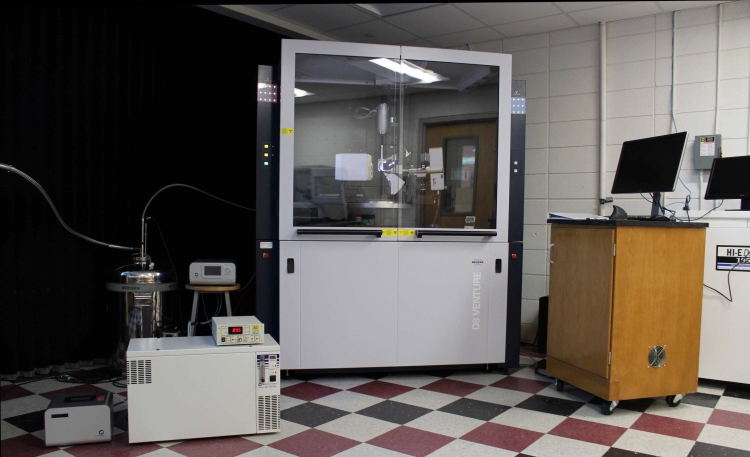X-Ray Facility
Single X-Ray Diffraction:
The X-ray facility in the Chemistry Department at Mississippi State University hosts a Bruker D8 Venture, providing a state-of-the-art platform for small and medium sized molecule analysis by X-ray diffraction. The system uses a dual wavelength configuration for small-molecule and protein crystallography. The dual microfocus source (copper/molybdenum) is equipped with a three-circle fixed Chi (54.7˚) sample stage goniometer, providing an open geometry and allowing for easy mounting of additional crystal-conditioning devices.
A motorized third generation Photon III – Mixed Mode X-ray Detection system is equipped. This detector offers mixed mode detection, simultaneously counting and integrating photon signals. This latest-generation detector provides high quality data for both strong and weak reflections. In addition, shutterless data collection is possible, which allows for full analysis in one hour or less for a well diffracting sample. Finally, the system is equipped with a Cryostream 800 (Oxford), the latest-generation liquid nitrogen cooling system. This feature allows variable temperature experiments over the range of 90 to 300 K.
Overall, this state-of-the-art multipurpose system is optimized for the analysis of small and medium sized organic and organometallic molecules. However, it can also be used for minerals and macromolecules.

List of some experiments and analyses can be performed:
- Single X-ray diffraction analysis using Copper or Molybdenum X-ray radiation.
- Fast crystalline phase identification using the Cambridge Data Bank; CCDC.
- In-situ X-ray experiments under irradiation: UV.
- Variable measurement temperatures in the range : 90 to 300 K, for phases transitions determination.
- Characterization of enantiopure organic or organometallic molecules by absolute configuration determination.
Powder X-Ray Diffraction:
A fully integrated powder diffraction system, the AXRD Benchtop from PROTO Manufacturing, is available for x-ray powder analysis. This system provides highly accurate and reliable measurement results comparable to the full-sized laboratory units. Capable of state-of-the-art high-speed data collection and equipped with a powerful hybrid photon-counting detector, the DECTRIS MYTHEN2.R.1D, allows the collection of low-resolution scans in few minutes, high-resolution scans in 15 minutes, and one hour for very-high resolution scans. Three scan modes are available:
- Coupled θ/2θ; (Bragg Brentano configuration)
- Decoupled θ/ θ for Rocking Curve
- Decoupled θ/2θ for reflectivity studies, grazing incidence and thin films analysis
In addition, a six-position sample changer, an airtight sample holder for environment-sensitive samples and a variable temperature chamber for in situ temperature experiments can be used.

List of some experiments and analyses can be performed:
- Crystalline phase identification and quantification.
- Search/match against COD and ICDD databases: ICDD, PDF-4+ 2020 is available in the department.
- Quantitative phases analysis.
- Whole-pattern fitting (Lebail/Pawley and Rietweld refinement methods).
- Determination of the ratio of crystalline to amorphous material in bulk materials and thin films.
- Measurement of average crystallite size strain.
- X-ray reflectivity: grazing incidence at low angle as low as 1˚ (surface studies and layers) and rocking curves (crystal defects study, mosaic spread, inhomogeneity, etc.).